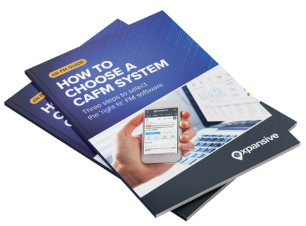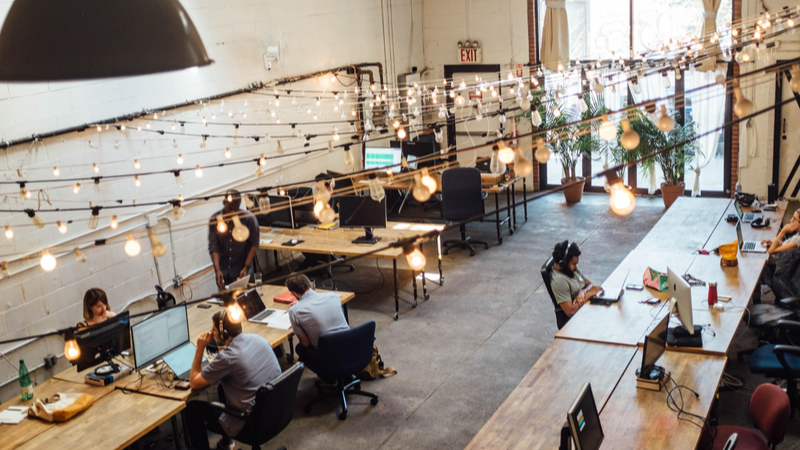Hybrid working is more than a buzzword or a passing trend. The latest IWFM research shows that post pandemic nearly half (44%) of UK employees are planning to work from the office for 3 days a week or less. Many big name firms including Microsoft, Ford and Citigroup are switching to flexible, hybrid working models to maximise productivity and open up new potential in their workforce. But what will this mean for facilities management and the digital tools we use?
What is hybrid working?
Hybrid is a flexible working model where employees divide their time between the office and remote locations to work in the way that is most productive for them and their employers. In this model offices are shifting from places where people come every day to complete ‘heads down work’ to centres for meeting and collaboration.
Offices for hybrid workers need to be flexible and configurable in the way they are furnished and laid out. They need to be equipped with tech to enable mixed presence teams (some in the office and others present remotely) to work together in real time. And workers will need more flexible access to bulky equipment like desks, chairs as well as technology - to support their work at home. Right now many businesses are actively transforming their workspaces and helping their workers meet these new needs. And FMs are pivotal to planning and executing the strategy.
Three challenges for FMs in the hybrid working revolution
1. How can we serve the hybrid model properly?
For many businesses Covid has been a mass testing ground for the flexible way of working that some employees had been campaigning for years to achieve. And many employers who had resisted remote working have found their businesses have flourished under these strange conditions.
Even Mark Zuckerbeg at Facebook has become a convert to the hybrid world:
“The thing that’s been positively surprising to people is that people are more productive working at home than people would have expected. Some people thought that everything was just going to fall apart, and it hasn’t. And a lot of people are actually saying that they’re more productive now.”
But employees have definitely missed face to face interactions and felt the impact of loneliness and isolation on their mental health and creative spark.
And that’s why a new breed of office space is going to be so important in the age of hybrid working.
As Natalie Douglass, the director of talent strategy consulting at New Street Consulting Group said in this Guardian article:
“What a lot of workers have discovered over the past year is that having the option to work remotely can be good but not having the option to go to the office at all can make a job much harder,”
For many, the workspace is transforming from a place we attend each day to sit at desks - to become a destination for less frequent but more focused activity. A centre for meetings, socialising and creative collaboration, where we come together with a shared purpose.
This is the future of the office as ‘third space’, a versatile and ever changing office landscape, with FM supporting different teams as they reconfigure spaces ‘on the fly’ adapting to different kinds of activity.
In these spaces we’ll be seeing;
- More agile furnishing options - desks/chairs/work benches used for different people/different tasks
- More flexible floor layouts so that spaces can be turned from meeting hubs to collaborative spaces
- More complex tech to support ‘mixed presence’ teams more effectively
- More food and eating options to make spaces more welcoming/homely
Workspaces will need to become more experiential; they’ll need to be highly rewarding, inviting and versatile to support the new expectations of a hybrid workforce.
And in answer to this FM teams will need to be more responsive, mobile and in constant communication with each other to ensure;
- Spaces are always clean and ready for use
- Agile furnishing is compliant and safe to use
- Tech is well maintained and secure
CAFM tools that can help teams communicate, co-ordinate and serve changing spaces quickly and efficiently will become a priority in this fast moving world.
2. How will we know if hybrid’s working? Where’s the data?
But the great hybrid working experiment has only just begun. For the first time many companies have invested significant money and resource in facilitating bold new working practices.
PWC has spent millions on VR headsets for staff to hold immersive virtual meetings for ‘mixed presence’ teams. HSBC has scrapped its executive floor in its Canary Wharf HQ to ask senior management to hot desk with the rest of their teams. Other companies are shifting to ‘hub and spoke’ office models, with smaller regional offices creating co-working spaces where workers can come to work without the grinding commute.
So, how will companies know if these reconfigured offices and changing practices are working?
If hybrid working is about to change the way our spaces are used we need the data to monitor its success and respond to changing needs.
Yet most businesses just don’t have this data at their finger-tips and without this how will businesses be able to tell:
- If repurposed workspaces are being used in expected ways?
- If they’re being serviced adequately?
- If assets and workspaces are under new stress?
- If assets are being moved around buildings?
CAFM systems can show us exactly these trends. Using FM software you can see where maintenance requests and costs are increasing by day and office type, as buildings are subject to new working rotas and constant reconfiguration.
It can help us keep track of assets, maintain their condition and ensure H&S compliance even as they are shifted around offices and to other locations.
3. How can FM’s lead from the front?
The perfect storm of leaps in digital collaborative tech and the forced closure of offices by Covid has accelerated the hybrid working revolution. It’s paving the way for some of the most radical changes to working practices since the computer first appeared in our workspaces a generation ago.
Now it seems the hybrid model may be the future for many of us, but it’s still a work in progress. Businesses are experimenting with new technology, new space layouts and new working practices to see what is most suitable and successful for them. We don’t know what the long term impact of these changes will be on working lives, productivity and the buildings we use. But businesses need the FM tools and data to implement the changes and measure its effects.
As we’ve seen, CAFM systems are going to be critical to bring these plans and experiments to life - to ensure the facilities and equipment we’re using are responsive, comfortable and safe for everyone.
But the data that these FM tools will serve up will be fundamental to deciding what strategies are working, what problems they might be creating and how much they are costing businesses to service and maintain.
Hybrid is an opportunity for FM to take the strategic lead. With the right CAFM tools in place FM teams will be able to offer real time insight into the success of these new ways of working. But they’ll also be able to suggest ways to change and optimise spaces to make them work harder and more cost effectively.
Without these software tools, however, we risk walking blind into the most disrupted period of workplace history since the beginning of the digital age. Now, that would be ironic.



